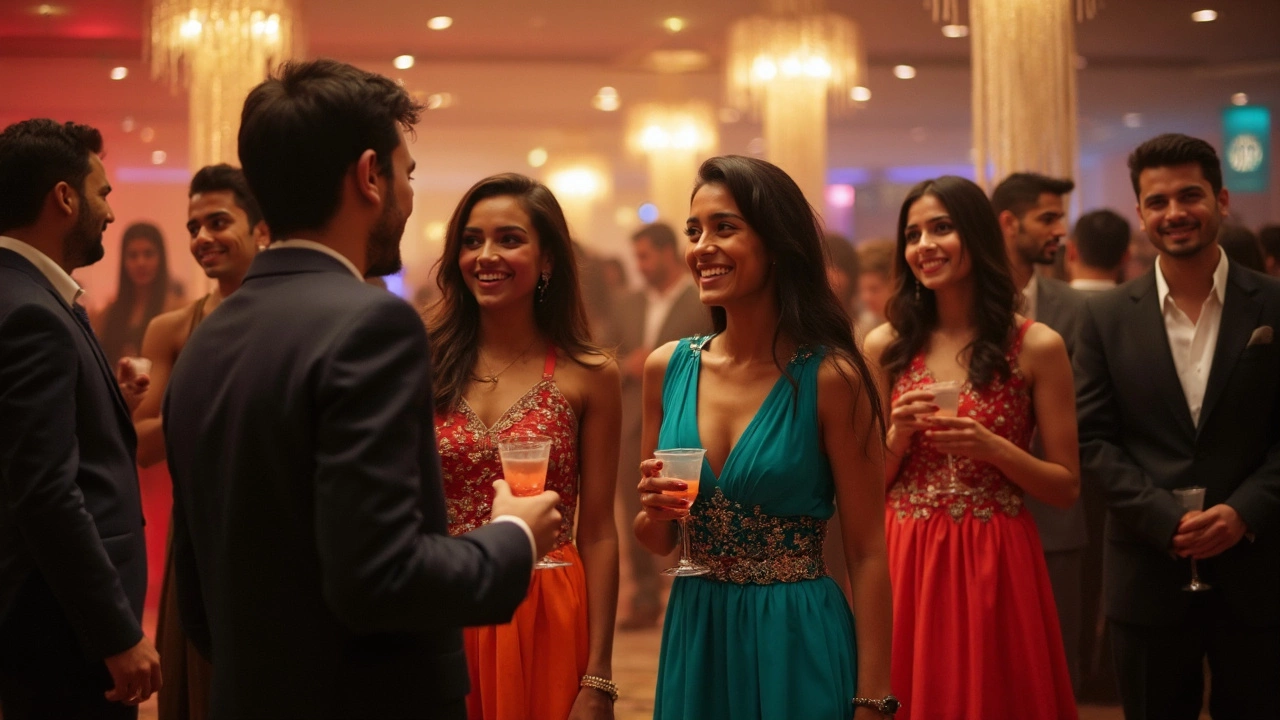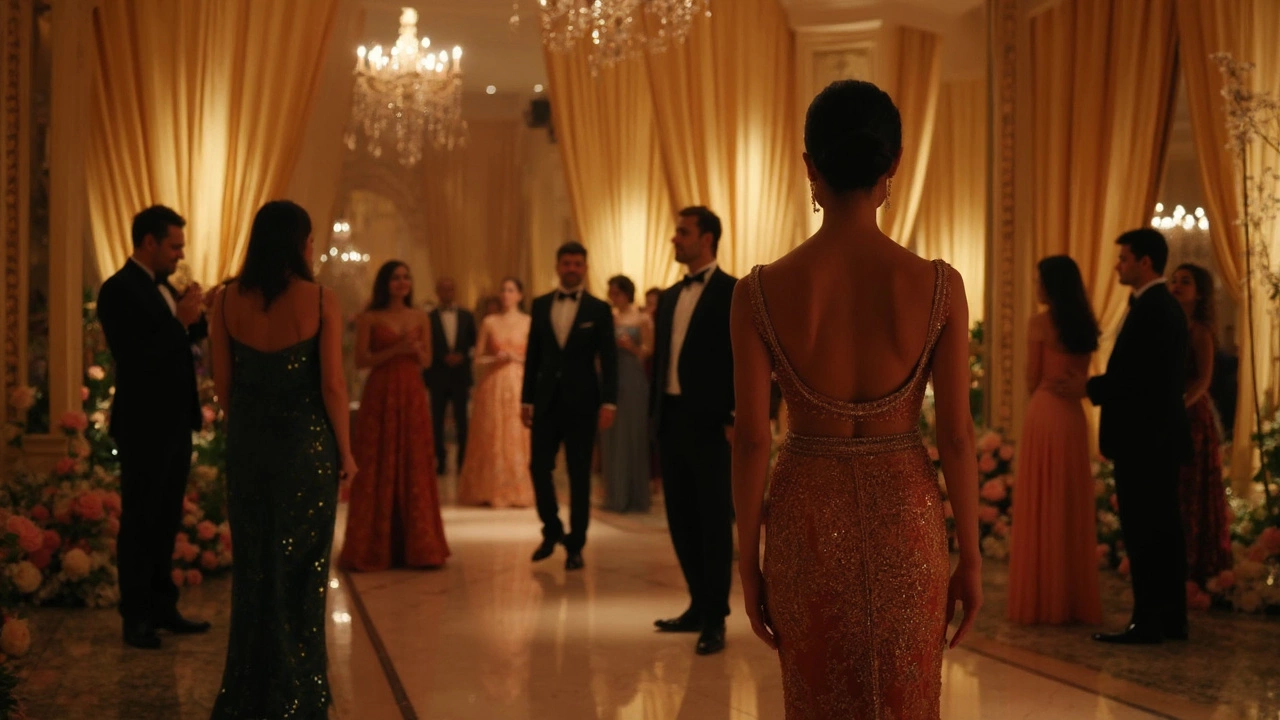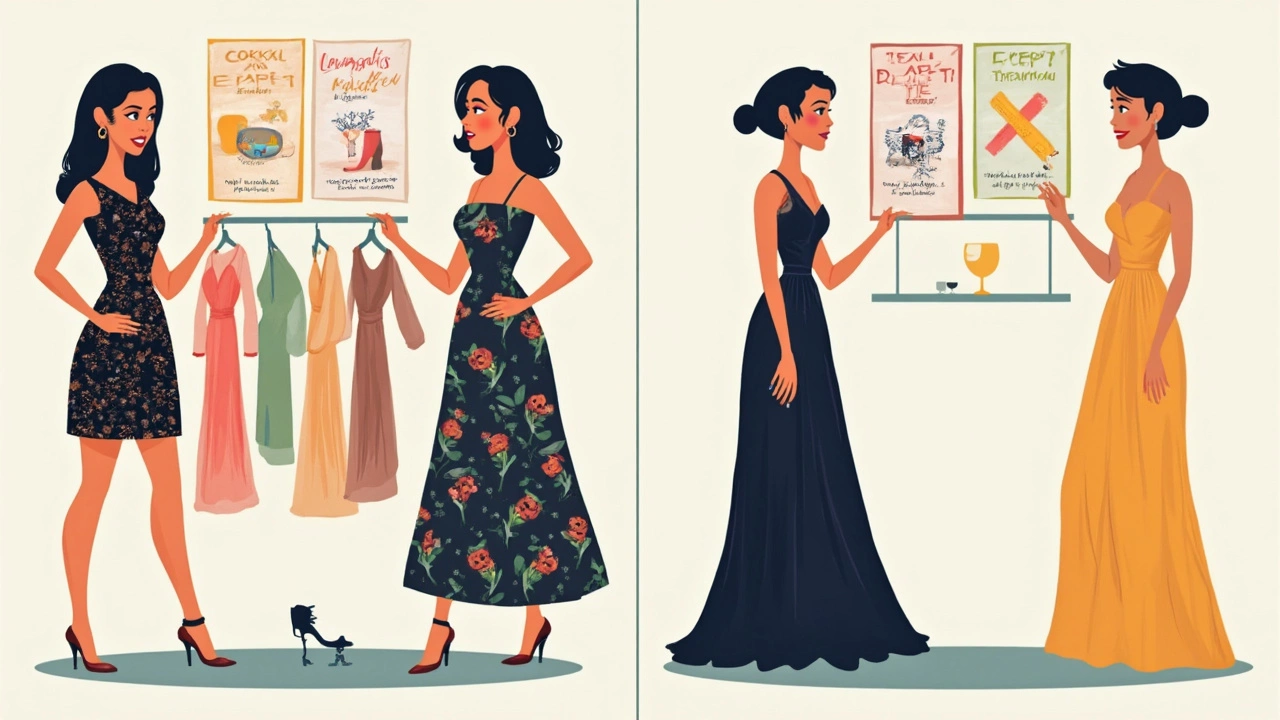Cocktail Dress vs Evening Dress: What's the Real Difference?

Ever get stuck figuring out if your cute cocktail dress counts as an evening dress? You’re definitely not the only one. Stores and websites blur the lines all the time, and dress codes on invitations rarely help. One friend says her short sparkly dress is 'evening,' another calls the same thing 'cocktail.' Where's the line, and does it even matter?
It kind of does. Whether you’re heading to a wedding, holiday party, or fancy dinner, knowing the difference means you show up looking just right—not too formal, not too laid-back. Let’s break it down so you’ll never feel lost scrolling through racks or trying things on in a rush. Here’s how to spot the difference and pick the one that matches your vibe and the event.
- Defining Cocktail Dresses
- Classic Evening Dress Essentials
- How to Tell Them Apart
- When to Choose Which
- Smart Tips for Any Dress Code
Defining Cocktail Dresses
Cocktail dresses are the go-to choice for a lot of semi-formal parties and events. You’ll spot them at work parties, weddings that don’t say “black tie,” and pretty much any gathering where jeans won’t cut it but a full-length gown would be too much.
So what actually makes something a cocktail dress? The typical version hits above the knee or stops right at the knee. You’ll rarely find a cocktail dress longer than mid-calf. Strapless, spaghetti straps, fitted, A-line—they come in just about every style, but they always look a bit dressy compared to everyday clothes.
Most cocktail dresses are made out of nicer materials like silk, satin, crepe, or chiffon. They're designed to stand out a little, sometimes with sequins, lace, or fun details that make you want to dance. Think sleek, simple, and definitely meant for an evening out, but not something you’d wear to a very formal gala.
- Hemline: Above the knee to just below it
- Fabric: Fancier than daily wear, but not heavy or over-the-top
- Event: Afternoon weddings, work parties, holiday celebrations
- Style: Usually easier to walk, dance, and sit in than a big gown
Here’s a quick comparison of typical cocktail dress lengths and when you might see them in action:
| Length | Common Event |
|---|---|
| Mini/Above Knee | Nightclubs, birthday parties |
| Knee-Length | Company parties, engagement parties |
| Tea-Length (Mid-calf) | Daytime weddings, semi-formal dinners |
If you’re ever not sure, check the invite for words like “cocktail attire”—that’s your signal to leave the ballgown at home, but to dress up a notch from your usual look. When in doubt, keep it simple with a classic cocktail dress in a solid color and add your personality with shoes or jewelry.
Classic Evening Dress Essentials
So, what exactly makes an evening dress different from the cocktail crowd? Think longer hems, fancier fabrics, and a whole lot more drama. The traditional evening dress is built for after-dark events where formality is the main thing—they’re what you’d expect at charity galas, grand weddings, or black-tie dinners. We're talking floor-length gowns, but not always. Sometimes, an ankle-length or tea-length gown counts if it’s dressy and elegant enough.
The main clues are right in the details. Classic evening dresses go for luxury fabrics—like silk, velvet, taffeta, or even heavy satin. Shimmer, sequins, or beading aren’t off-limits, but they’re usually balanced by a simple cut and a lot of attention to quality. Strapless, long sleeves, halter, and off-the-shoulder are all fair game. The idea is to look put-together and polished, rather than flirty or fun.
- Evening dress lengths: full-length, sometimes ankle or tea-length
- Fabrics: silk, velvet, satin, taffeta, chiffon
- Details: subtle beading, lace, or metallic touches for a luxe look
Pockets in an evening dress? Rare, but not impossible. Lower-back zippers, fitted waists, and lines that flow outward from the waist or hips are super common. When it comes to color, deep jewel tones or classic black are most popular for big events, but pastels or metallics show up too.
| Feature | Evening Dress |
|---|---|
| Hem Length | Usually floor/ankle/tea |
| Fabric | Silk, velvet, satin, chiffon |
| Common Colors | Black, navy, red, emerald, metallics |
| Dress Code Match | Formal, black-tie, gala |
If you’re unsure whether a dress qualifies as "evening," this checklist comes in handy: long hem, upscale fabric, chic details. Nail these, and you’ll blend right in among the best dressed at almost any fancy event.

How to Tell Them Apart
So, what really sets a cocktail dress apart from an evening dress? It’s mostly about length, fabric, and the vibe you give off. Let’s break down the differences in plain English.
- Cocktail dress: Hits around the knee or a bit above. You’ll see them at office parties, date nights, or less formal weddings. Fabrics are nice but not too glitzy—think silk, satin, velvet, or even a thick crepe. The looks range from playful to classy, but never dramatic.
- Evening dress: Usually long—with hemlines trailing right to your ankles or the floor. You’ll spot these at black-tie events, galas, and formal weddings. The fabrics here get serious: luxe satin, chiffon, lace, or sequins. Shapes can be fitted, flowy, or even “mermaid” style. Details like beading or dramatic sleeves are common.
Here’s a quick table you can check whenever you’re on the fence:
| Feature | Cocktail Dress | Evening Dress |
|---|---|---|
| Typical Length | Knee to mini | Ankle to floor |
| Main Fabrics | Satin, crepe, velvet, jersey | Silk, satin, chiffon, sequins, lace |
| Occasions | Semi-formal, parties, casual weddings | Black tie, galas, formal events |
| Details | Simple, sometimes fun | Elegant, may have beads or sequins |
| Shoes | Heels or nice flats work | Usually heels, often dressy |
Some department stores label anything above the knee as a cocktail dress, even if it’s covered in sequins. That’s just retail logic, not social rules. Usually, a cocktail dress is your go-to for anything between casual and black-tie—a sweet spot where you look great but not over the top.
Color isn’t a strict rule, but dark shades (black, navy, jewel tones) feel fancier even if your dress is shorter. Light, flirty prints usually say "cocktail" while solid, dramatic colors fit both styles depending on the cut and length.
When to Choose Which
This is where the dress code drama gets real. You don’t want to show up to a black-tie gala in a short, flirty cocktail dress, but you also don’t want to wear a dramatic floor-length gown to your friend’s birthday dinner at a restaurant. Here’s how to pick what's right for the night so you never second-guess your choice in front of the mirror.
If the invitation says “cocktail attire,” go for a classic cocktail dress. Think knee-length, mid-thigh, or tea-length. These events include most engagement parties, after-work holiday parties, or semi-formal weddings. They aren’t overly fancy, but jeans or super casual dresses usually won’t cut it. Look for fabrics like satin, crepe, or a hint of sparkle. Cocktail dresses are also the go-to for date nights that feel fancier than usual.
When the invite says “evening dress” or “formal/black tie,” it’s time for something more elevated. Evening dress usually means full-length, sometimes midi if the style is dramatic or the dress code feels less strict. Here, reach for luxe fabrics: velvet, silk, tulle, or all-over sequins. These dresses are meant for galas, charity balls, evening weddings, and formal award ceremonies. It’s a whole mood—think red carpet, not rooftop bar.
| Event | Cocktail Dress | Evening Dress |
|---|---|---|
| Semi-Formal Wedding | ✓ | |
| Holiday Office Party | ✓ | |
| Black Tie Gala | ✓ | |
| Fancy Dinner Date | ✓ | |
| Opera/Ballet | ✓ | |
| Charity Ball | ✓ |
Here’s a rule you can actually use: When in doubt, double-check the location and time. If the party starts at 6 p.m. or later and takes place in a banquet hall, ballroom, or similar, that’s usually a hint that an evening dress is safer. Daytime or casual venues? Play it safe and stick with a cocktail dress. Don’t forget—if you’re pressed for answers, you can always text the host. Saves a lot of stress (and a lot of closet panic).

Smart Tips for Any Dress Code
Dress codes can feel like a trap, especially when the invite just says “evening attire” or “cocktail chic.” Skip the panic. Here’s how to pick the right look every time without second-guessing yourself.
- Check the invitation. If it says “black tie,” an evening dress is a must—a cocktail dress is usually too casual. For “cocktail attire,” go shorter and simpler but avoid something so basic it could pass as a sundress.
- When in doubt, it’s always better to be a bit overdressed. No one ever remembers the person who looked too put-together, but people do remember underdressed guests.
- Think about the time and place. Early evening events or rooftop parties, for example, often lean toward cocktail dresses. Formal evening weddings or theater nights call for longer, dressier options.
- Fabric matters. Satin, chiffon, or velvet scream dressed up, while cotton or jersey are often too casual.
- If you’re attending with a +1, like I do sometimes with Lucas, coordinate on how dressed-up you’ll both be. You don’t want to outshine or underwhelm each other.
Here’s a quick table to help you decide if you can pull out your favorite cocktail dress or if a classic evening gown is better:
| Event | Acceptable Dress | Length | Notes |
|---|---|---|---|
| Black Tie Wedding | Evening dress | Long | Stick to darker tones, dressy fabric |
| Cocktail Party | Cocktail dress | Knee-length or mid-thigh | Add statement jewelry, bold clutch |
| Charity Gala | Evening dress | Full or tea-length | Classy details like lace or beading work |
| Office Holiday Party | Cocktail dress | Not too short, cover shoulders if possible | Keep it fun but not revealing |
| Formal Dinner Date | Cocktail dress or short evening dress | Knee-length | Heels and a sleek bag polish your look |
Always remember, confidence beats any dress code. If you feel good in your outfit and know you’ve matched the vibe of the event, you’re set. Spend time making sure your dress really fits—good tailoring can make even the simplest dress look expensive. And last tip: keep a pair of comfy backup flats in your bag. Trust me, you’ll thank yourself after three hours in heels.